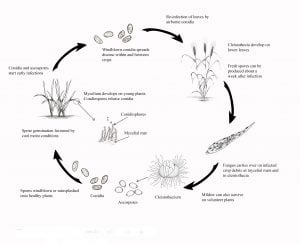In recent years with the increased susceptibility to powdery mildew in the dominant wheat varieties this disease has become increasingly important. The powdery mildew that attacks wheat (Blumeria graminis f. sp. tritici) will not attack barley and visa-versa.
The disease is most common in lush, early sown crops with adequate nitrogen nutrition. It is first observed during tillering but does not normally persist beyond ear emergence, but given suitable conditions can impact grain yield.
What to Look For
At first, small, yellow spots appear on the leaves. Several days later a white fluffy fungus can be seen in these spots.
The fungus can infect all above-ground parts of the plant, including the head. It causes yellowing and early death of leaves. Later in the season the fungus produces small black specks. These are commonly found in old infections near the base of the plant.
Disease Cycle
Each mildew infection produces masses of tiny, white spores. These are readily blown about by the wind, spreading the disease. The fungus needs a high humidity but not rain or dew to infect the plant. Development of powdery mildew is greater at mild temperatures (15-22°C) and in lush crops.
Mildew symptoms usually appear five to seven days after infection. The fungus can multiply quickly, and crops can become heavily diseased within four to five weeks of the first signs of the disease. The disease most likely carries over from one season to the next on the stubble. Mildew from one cereal (e.g. barley) will not infect other cereals (e.g. wheat).
Powdery Mildew of Wheat Management
Fungicides
There are both seed and foliar fungicides available for the suppression of powdery mildew in wheat. As mildew builds up on the base of plants foliar applications before canopy closure are usually more effective as the fungicide is able to reach the target. It is for this reason that effective seed or fertiliser treatments are important for control of this disease.
Cultural
No stubble treatments or crop rotations will effectively control powdery mildew because spores can be readily blown onto a healthy crop from diseased crops in the district.
Varietal resistance
There is variation in wheat varieties to their reaction to powdery mildew. In areas prone to powdery mildew avoid highly susceptible varieties if possible. Current varietal disease ratings for powdery mildew can be found in a current Victorian Cereal Disease Guide or the NVT website.
Please note: This book is also available on AppleBooks




